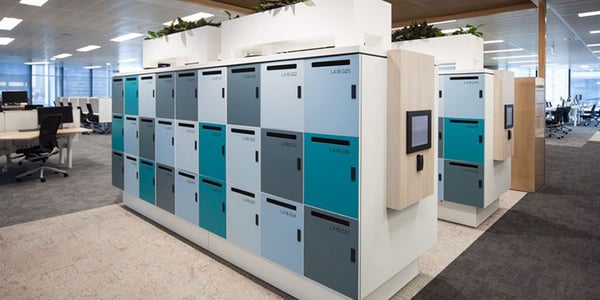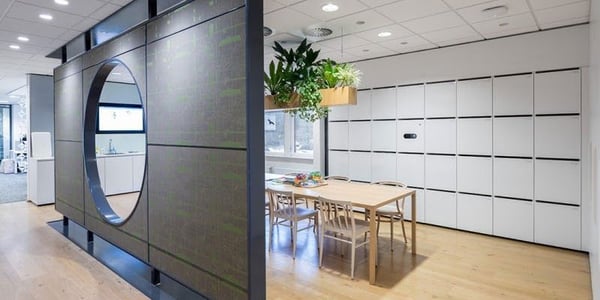Workplace design doesn’t often make the mainstream press. That’s just one more thing COVID-19 has changed. Even the New York Times is weighing in on “changes to the modern workplace culture.” At Patterson Pope, we’re considering how the changing workplace impacts storage decisions. Fortunately, many of our solutions support social distancing, cleanliness and peace of mind at work.
Around the United States, several states are beginning to cautiously reopen for business on site. In doing so, they’re looking at everything about the work environment differently. Experts interviewed in the several articles now available agree changes could include:
- Reducing the number of people in an office space
- Moving desks further apart
- Doing away with shared desks or hoteling
- Reconfiguring ventilation to push air down to the floor rather than up to the ceiling
- Installing hand sanitizers and disinfectants in conference rooms and meeting spaces
- Employing cleaning crews during the day for more frequent disinfecting of work areas
- Marking safe zones where people can stand to await elevators
- Adding infrared body temperature scanners to offices
- Installing signage to point traffic in a work environment in a one-way direction
- Implementing clean desk policies which ask employees to remove photos, tchotchkes and other items which can collect germs
A 12-page document produced by CBRE, one of the world’s largest commercial real estate firms, suggests adding “tall laminate gallery panels to workstations or benching stations” to create more biological isolation in the office. Think of a sneeze or cough guard at a deli or ticket booth, and imagine that added to a worker’s cubicle.
Smart Storage – an Emerging Trend
Another area where designers can think strategically about workspace proximity and providing reassurance to the end-user of the space? Storage solutions.
Smart storage can help delineate a workspace and provide more division in common areas. Further, our smart solutions can contribute touchless technology to curtail germ spread and data that helps efforts to trace possible infections. Plus, finish choices should be a consideration in thinking about how to disinfect more often and effectively. Let’s consider each of these options in more detail.
Delineating Space
Some suggest ropes to divide spaces, but hard surface dividers are easier to clean and disinfect. Movable walls or locker walls are viable options. A storage island can also increase shielding between people while giving workers somewhere they can secure their personal belongings.
The advantages of incorporating storage into space delineation efforts include:
- Flexibility. You’re not adding drywall divisions. You can move modular storage solutions around as needs change and adapt to space evolutions.
- Security. These solutions provide your people with peace of mind that their stuff is safe and out of the way.
- Reducing Contact. With day-use or parcel delivery lockers onsite, your business can reduce person-to-person contact. Plus, making these lockers available to employees for dry cleaning, grocery or meal delivery can reduce the need for people to go off-site during the workday.

Touchless Technology
One focal area for CDC guidelines about getting back to work is reducing touchpoints. We can expect employees will be using personal devices to cut back on device sharing and automatic soap dispensers and faucets are going to be increasingly common.
At the same time, there are other places to reduce physical touches. Along with developing a clean desk policy, the organization might think about assigning lockers, file drawers or storage cabinets to individuals to store personal items. Where that’s the case, you’ll want to leverage electronic, hands-free locking mechanisms.
Patterson Pope offers networked lockers that can be opened using a touchless scan of an RFID employee badge. Or the individual might log in to an app on their phone or wearable device and use that to prompt the locker to open.
Gensler dedicated an article to “Understanding the Touchless Workplace.” It noted, “a system that recognizes your people and automatically grants them access is the epitome of frictionless.”
Data Dashboards
Networked lockers and drawers or cabinets secured with smart technology provide useful data too. Say an employee comes down with an illness. The administrator can go to the data dashboard and determine which locker that person was using in the days before at work.
Or a work campus that wants to do a deep clean can use data to identify areas that need attention. Plus, they can do so more efficiently by being able to open an entire bank of lockers with one click of the computer. That’s a lot easier than unlocking each individual locker overnight.
Even the Material Matters
There’s also new interest in products that prevent the spread of germs and are easier to clean and disinfect. For instance, copper is getting attention right now as it is less hospitable to germs than some other surface materials.
Patterson Pope’s easy-to-clean laminate or powder-coated steel can also help an organization meet hygiene standards. We’re seeing increased interest in anti-bacterial and antimicrobial finishes that are durable in the face of frequent cleaning. Selecting a nonporous surface is on the rise as well.
Along with increasing handwashing and sanitation stations throughout the workplace, there’s a need for reduced absorbency materials. Reviewing furniture, fixtures and equipment materials to embrace anti-microbial properties and make things bleach cleanable can help.

Final Thoughts
There are many areas to consider in trying to reimagine the workplace post-pandemic. This article has explored some of the potential areas where the work environment will be re-envisioned. Particularly, we’ve outlined areas where storage solutions can make an immediate difference in repurposing familiar spaces.
Today’s offerings already help create space barriers, reduce touch, increase data awareness, and improve cleanliness throughout the workplace. Tomorrow’s offerings will go even further to protect workers - some we are working on right now!
Patterson Pope is committed to bringing to market the leading-edge solutions that support new mandates and business priorities. Our team of experts doesn’t just know stuff, we can support the smart technology we offer too. We’re a one-stop solution for your space and storage needs. And as we move into the arena of the “new normal”, we’ll be ready to help.











